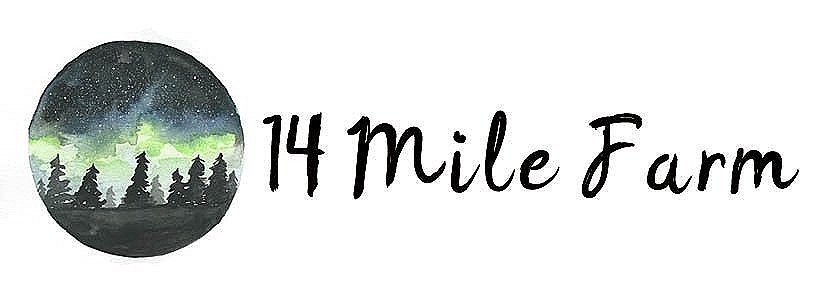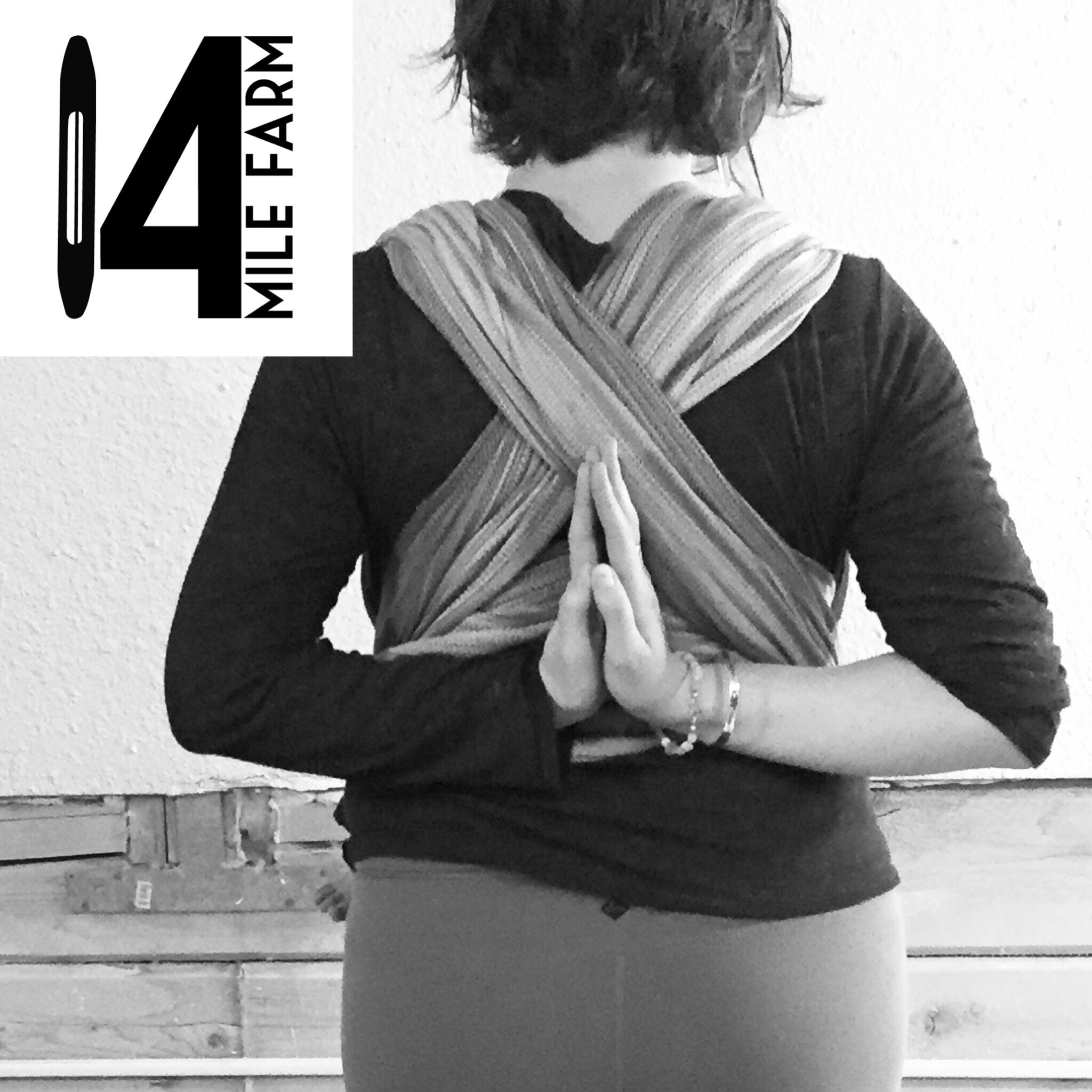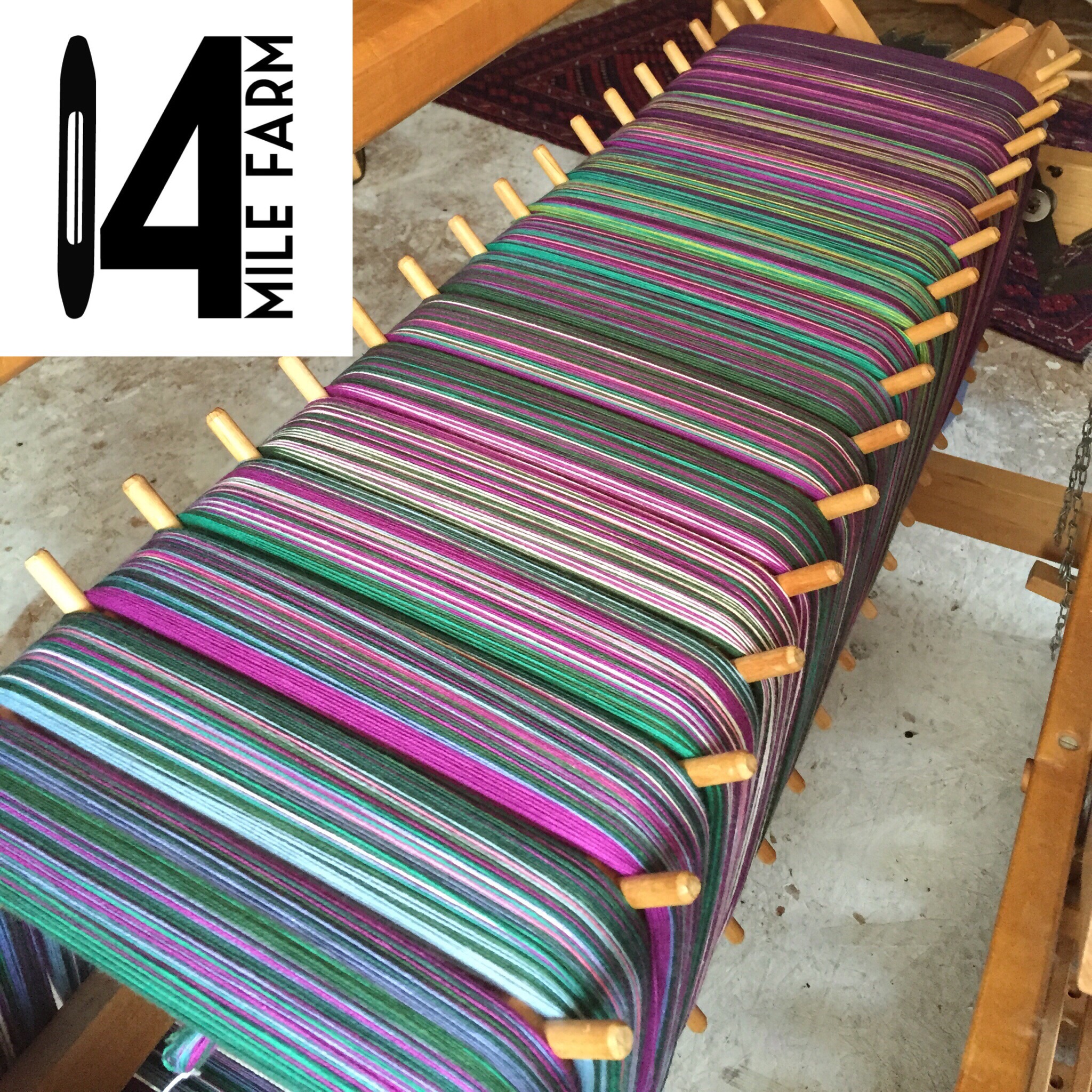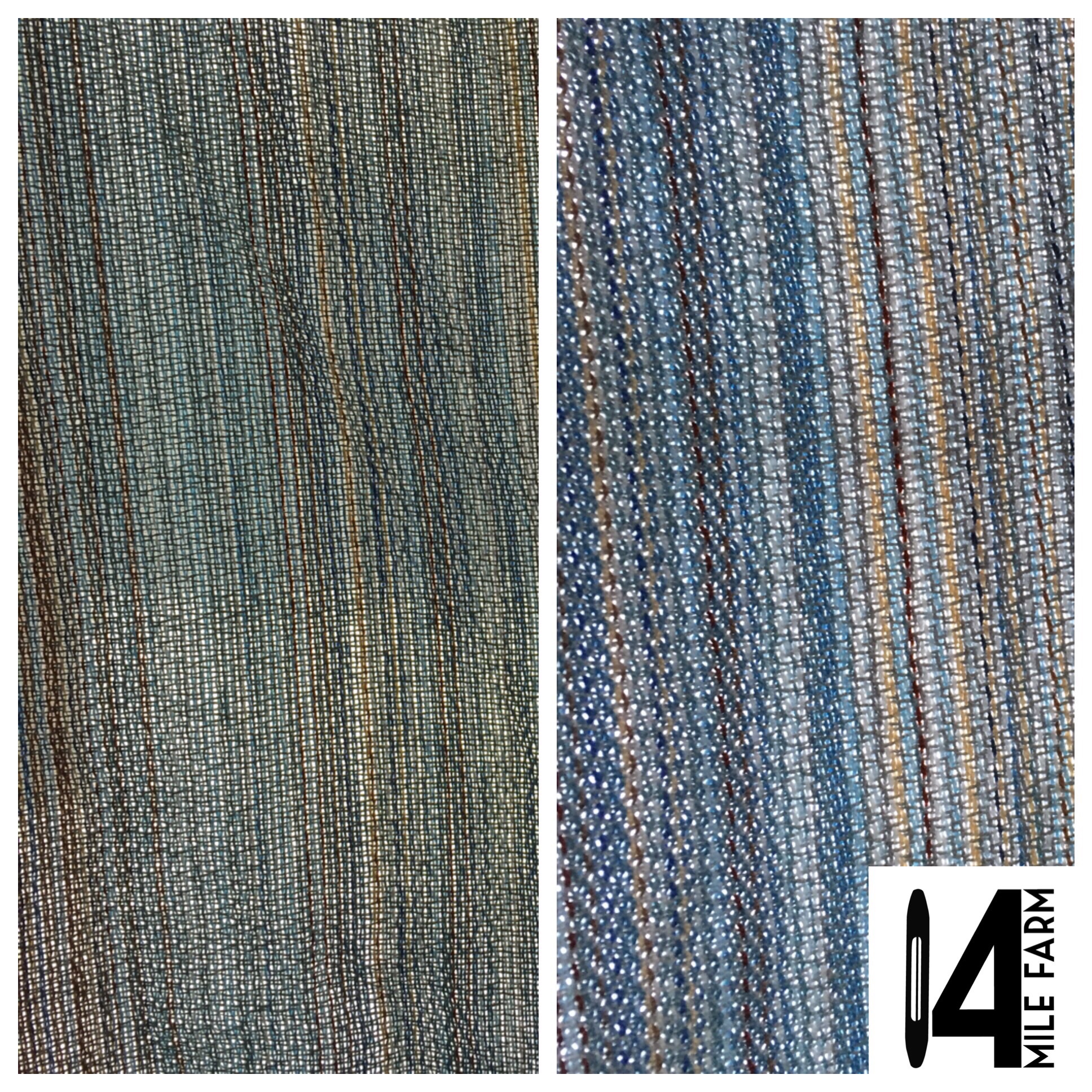Welcome! Please feel free to subscribe to the newsletter to get studio updates and projects from the archives straight to your inbox.
Babywearing Yoga
I recently participated in a babywearing yoga challenge on Instagram. It was a lot of fun, and I even experimented with making video tutorials for the poses which you can check out on the 14 Mile Farm Facebook page.
Babywearing Yoga makes for great selfies and lets face it, it is a real nice ego boost to look so bad-ass on your social media. If, like mine, your feed is filled with fellow yogis doing poses that are still inaccessible to you after a decade of practice and fellow mamas posting about their aspirational parenting in your Facebook mom's groups, it can feel good to post a bunch of babywearing yoga selfies. Or, oh my, does SSS (that's stash shot Saturday in the babywearing world) just make you droolingly envious and make you wish you had one meeeellllion dollars to spend on wraps? Babywearing yoga selfies are a feel good one-upsmanship.
All ego-boosting humor aside, babywearing yoga has a whole host of benefits to offer mama and baby. In addition to the closeness, the bonding, the healthy attachment that babywearing supports, doing yoga poses with baby models mindful movement. We know that a baby's neurology is a sponge: picking up on and learning from everything in their environment. Specifically, babies' mirror neurons learn from what is modeled via mimicry. When a caregiver's physiology falls into yogic patterns of deep, still, smooth breath, calm parasympathetic nervous system, and its calm steady heartbeat - baby learns from that. Many babywearing yoga poses also have specific benefits for the postpartum mother's body that we will get into with more detail below.
Warrior One is a great pose to start out with, the first time you step onto the mat with baby on your back. This is also a posture that's easy to do with baby in a front carry, belly to belly with mom. Its an easy one to ease into babywearing yoga with, because its easy to incorporate into a walk or a wrap nap, no mats required!
Always be aware of your balance when practicing asana with baby on board. Feel your center of gravity extending down through tailbone and rooting to the earth beneath you. Be sure to keep the front knee directly over the ankle and in line with the toes for optimal stability for both you and your joints!
Warrior One is pose of strength and stability, it asks you to ground into your connection with the Mother Earth. At about 6 weeks post partum you can begin to consciously work on strengthening and engaging the muscles of the pelvic floor and the deep core. This pose is great for this work as it engages the muscles of thighs and legs and brings them on board to support the work of the core.
Utkatasana, or fierce pose, is also often known as chair pose. It is another one that may be easily practiced with babe on front.
This pose is the perfect invitation to work on the pelvic floor and core muscles as you deepen the sitting action. Be sure to keep breath soft in the belly, and find a fixed point upon which to focus the eyes. This practice, combining endurance, challenge, commitment, as well as the conscious softness and ease of deep breath is in some ways the perfect microcosm of motherhood.
Vrksasana or Tree pose is one of my all time favorite yoga poses ever. And it just gets better with baby! Babe can be on front, belly-to-belly, or in a back carry. The key is to have babe's weight centered on your body. Hip carries might not be the best option for this pose.
Tree pose, as with all balancing postures, is a practice of moving towards center. It is not necessarily a practice of resting in perfect stillness. When you feel yourself leaning towards one side, correcting towards the other side and overshooting center, swaying in the posture; the body is learning. Core muscles, hip muscles, foot muscles, are all mapping gravity, learning how best to keep you and babe's hearts centered and upright.
Plank pose, or the top of a push-up, is a pose that I only reccomend to practice if you you are proficient and comfortable with back carries. Baby on your front is maybe not a great idea for this posture. It is however a GREAT posture to work on core strength and deep stabilizing muscles. ** Please note that it is always a great option to come down onto the knees for this posture. It is better to maintain posture (especially through the lower and mid-back) and challenge yourself where you are at than it is to push into postures that are not sustainable.
The key here is to keep shoulders and hips in line with one another. It is really really easy, especially with the added weight of baby, to let the base of the ribs drop towards the floor. Instead think about broadening through the kidneys and lengthening through the low back. Your body will arrange itself in two lines here, spine and legs with a hing between the two. It is NOT the goal to make one unbroken line from head to heels.
If you cannot easily and freely breathe in the pose, modify it by coming onto the knees and choose to challenge yourself instead by holding it for a longer period of time.
Cobra pose or Seal pose (a deeper back bend, pictured here) is another posture that is only really appropriate with back carries. If you wear babe on the front, Camel pose (ustrasana) is a great alternative.
Practicing this pose properly and effectively requires active engagement of the core muscles. A supple pelvic floor and soft shoulders will also aid you.
Start with the entire front of the body on the floor. Hands are under shoulders, tops of feet, toes, tops of thighs and fronts of hips press downwards into the mat. Imagine the tailbone extending towards the heels. Let shoulder blades be soft underneath baby, behind the heart. Then using the hands as support, peel the torso off of the floor any amount. Hold the backbend for a breath or two or 5, and then slowly lower yourself back down.
Malasana, or Garland pose, is a deep squat that is hugely nourishing to the pelvic floor, perineal tissues and the digestive system. Feet and knees are slightly wider than the hips here, allowing the hips to sink between the knees. They can face in any direction that is comfortable so long as the knees and toes are pointing in the same direction. You'll notice that in the picture my feet are flat against the floor. If your heels do not comfortable rest against the floor simply tuck a rolled blanket or yoga mat underneath the heels so that the entire sole of the foot is able to active press into the ground. This allows the muscles of legs, hips and core to work optimally in the posture. This is another great one for exploring your center of gravity as you invite the tailbone to reach ground-wards and invite the spine to stack and elongate.
Did you know that children, babies especially, mirror the physiological state of their caregivers? This is actually true of adults and is a human neuro-physiological trait that therapists use to facilitate the healing work they do. When momma is stressed and freaking out, baby will not only pick up on that, but her heart will begin to mirror momma's increased heartbeat, baby's breath with mirror momma's becoming shallow. Likewise, we can use our physiological state - deep calm breaths for instance - to help calm a fussy child.
Yoga breath work is a great way to being to train our neurology and our physiology to settle into soothing state of deep calm and rest. When the body is familiar with a deep and easeful pattern of breath, it is a skillful tool that is more readily accessible in moments of stress - such as a tantruming child. Practicing breath work, therefore, is preparatory work for a gentle parenting approach.
Deep diaphragmatic breaths are perhaps the simplest yoga breath practice to begin with. My favorite however is Nadi Shodana (pictured), an alternate nostril breathing practice which balances the nervous system, calms mind and body, and nourishes the spirit.
Field of Dreams
Field of Dreams is the most recent warp to come off of the loom here at 14 Mile Farm. Its woven in a "crackle" weave by Ralf Griswold. The warp is 8/2 cotton from Maurice Brassard.
This wrap was inspired by the fireweed that blooms in the Alaskan summer.
Fireweed covers the landscape here in interior Alaska in the summers. It is a very resilient plant, the first to return to area after a forest fire, hence the name. Each flower on the stalk fluffs out like a dandelion in late summer and is blown on the wind to reseed the land for the next year.
It grows on roadsides, in meadows and fields, and covers the hill in our front yard.
The warp moves through spring to summer greens, with magenta and fuschia followed by the grey blues of a late summer sky, and natty pinstriping to evoke the the fluff of the fireweed going to seed.
Here we see the cloth building up on the cloth beam. It is one of my favorite and most satisfying sights as a weaver. You can see the weft change from the magenta to the greens.
This piece is woven with a magenta Tencel, and will be staying here with us. The combination of the grippiness of the crackle weave with the glide provided by the tencel makes for divine wrapping qualities.
A cowl in grey Tencel. Tencel in a crackle weave is one of my new favorite things. I love the play between the shine of the tencel and the matte unmercerized cotton. So soft!
This piece was woven with a hand-dyed variegated Tencel weft in shades of green and will be flying to a new home.
I love the way that the variegated greens are evocative of the oh-so-green summer landscape that fireweed blooms against. This weft came together even better than I had hoped.
Bands of magenta tencel in the tails of the variegated piece to highlight the bright color of the flowering fireweed.
The variegated weft was a joy to weave, always changing. I see more hand-dyed yarns in the future here at 14 Mile Farm!
What is wet finishing?
Many machine-woven baby wraps are delivered to the customer in loom state and the buyer must do their own initial wet-finishing. Most handwoven baby wraps, and all 14 Mile Farm handwoven babywearing wraps, are delivered to the customer post wet finishing and ready to wear.
Wet finishing is the final step in making a piece of cloth on a hand loom. It is easy to think that the fabric is complete when it rolls off of the cloth storage of the loom, but that is not the case. Handwoven fabric in “loom state” is not yet finished. Wet finishing is the process of washing and drying the woven cloth for the first time.
Bloom shot!
Weaving yarn is (for the most part) spun in industrial mills. The equipment that spins the yarn is lubricated with oil, and this spinning oil ends up lightly coating the spun yarn. The wet finishing process removes this oil, allowing the yarn to ‘bloom.’ As the fabric goes through the process of being washed and dried, the individual fibers in the yarn are able to fluff, shrink, and/or settle into their preferred state.
You can see the way the texture of the fabric changes, and the drape comes into being post-wet finish.
Measurements pre- and post- wet finishing can vary by 10-15% or more. Every yarn and every fiber combination will have different rates of shrinkage. In the case of wool wet finishing must be done carefully, allowing the wool to full (bloom) but not to felt. In general wool should washed in cold water with minimal agitation. Always follow your care instructions!
I was surprised by just how much the color of the warp was revealed post wet finishing. You can see the herringbone weave structure more clearly in the second photo as well. Both photos were taken in front of a window in very similar light. This change is due in part to the way that the wet finishing process lets the weft (grey here) really move three dimensionally going over and under the warp threads as it looses the two dimensionality imposed by tension on the loom.
Many machine-woven baby wraps are delivered to the customer in loom state and the buyer must do their own initial wet-finishing. Most handwoven baby wraps, and all 14 Mile Farm handwoven babywearing wraps, are delivered to the customer post wet finishing and ready to wear.










































